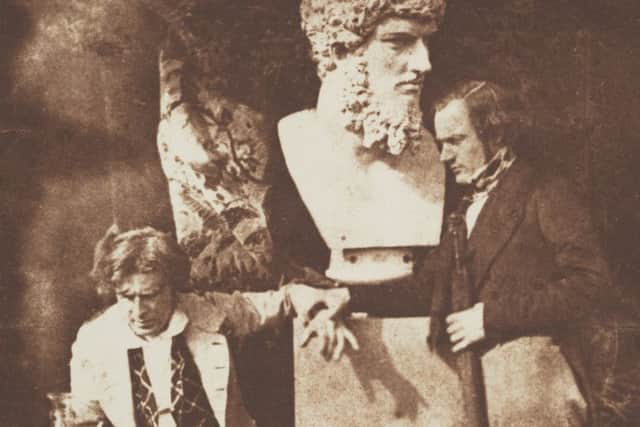Art review: A Perfect Chemistry - Photographs by Hill & Adamson
![Jeanie Wilson and Annie Linton [Newhaven], 1843-1847, by David Octavius Hill and Robert Adamson PIC: Scottish National Portrait Gallery](https://www.scotsman.com/webimg/legacy_elm_55842726.jpg?crop=3:2,smart&width=640&quality=65&enable=upscale)
![Jeanie Wilson and Annie Linton [Newhaven], 1843-1847, by David Octavius Hill and Robert Adamson PIC: Scottish National Portrait Gallery](/img/placeholder.png)
Robert Adamson had recently arrived in Edinburgh from St Andrews, having learned the practicalities of photography from his brother John. At the age of 22, he planned to set up the city’s first calotype studio, using the technique recently developed by William Henry Fox Talbot, and leased Rock House on Calton Hill for this purpose.
A Perfect Chemistry: Photographs by Hill & Adamson ****
Scottish National Portrait Gallery, Edinburgh


The meeting of the two men resulted in the “perfect chemistry” to which the title of this exhibition refers. Despite being 19 years apart in age and from wildly different backgrounds, they forged a partnership which would change the face of photography. For the next four-and-a-half years, until their collaboration was cut short by Adamson’s death, they would work and live together, taking a fledgling invention and turning it into an art form.
Advertisement
Hide AdAdvertisement
Hide AdBut the exact nature of that perfect chemistry remains a mystery. Like the photograph taken in Greyfriars Kirkyard (possibly by their trusted assistant, Miss Jessie Mann) which appears to show two men bent over a wooden box camera, they remain indistinct, hidden in shadow. They left behind an astonishing output of more than 2,000 calotypes, the most comprehensive collection of which is here in the National Galleries of Scotland (with over 100 in this show), but little in writing, little to tell us what they were like or how their partnership worked.
One can surmise that Hill brought to it a painter’s eye, and his connections to Scotland’s men of letters and of science, many of whom they photographed. Adamson brought photographic know-how, it seems to an impressive degree. Some of their finest work shows experimentation with light and shade, a kind of chiaroscuro; John Adamson described his brother’s pictures as “Rembrandtish”. What is also clear is that they began by working on Hill’s Disruption painting, but this was quickly superceded by the possibilities of the new medium. The exhibition is full of references to proposed books and projects, only one of which – Views of St Andrews – was ever published. They ran out of time long before they ran out of ideas.
Peering at sepia-tinted images of men in Victorian dress, it’s easy to forget how radical their practice was. At a time when photography was still a tricky process best left to patient amateurs, they saw its potential for exploring and recording. They seemed to understand, instinctively, that photography would one day be mainstream, that it would change how we see and capture the world.


They realised that the camera was capable of an immediacy, of capturing a moment, which other art forms could not do. They packed up their equipment – precious, heavy, fragile – and took it to Newhaven to capture the old ways of the fishing community, perhaps the first ever documentary photography project and still some of their most significant work. They photographed the Scott Monument under construction, the newfangled railway at Linlithgow, the moments they were witness to.
They seemed to be tireless in their fascination and output, and kept challenging their medium. They worked, by necessity, out of doors using natural light with exposure times of a few seconds going up to minutes depending on the light available, but they didn’t let technicalities restrict them. When they shot a tennis player, apparently in action, they used metal clamps and supports to help him hold his pose. Pictures which look like candid snapshots – The Picnic at Bonaly, Edinburgh Ale and the charming photograph of the McCandlish sisters lying in the grass – were in fact careful acts of staging, composition and (for the sitters) a lot of staying very still.
Another picture shows Hill, evidently hungover, a glass of selzer at his side, while his friend (and temperance reformer) James Miller takes his pulse with a mildly reproachful half-smile. It’s like being afforded a glimpse, at last, into Hill and Adamson’s world, that place of endless ingenuity and ideas and hard work and – it seems – a robust sense of humour. It is, however, a brief glimpse: most of those moments remain outside the frame.
When Adamson died in January 1848 at the age of just 26, Hill and his family continued to live in Rock House, but the photographic practice ended. Hill did, however, finish his painting, The First General Assembly of the Free Church of Scotland, which is also in this exhibition. It took him more than 20 years, with more than 400 subjects, and one of the first things he did upon finishing it was to commission a photographer, Thomas Annan, to create photographic prints for sale.
Advertisement
Hide AdAdvertisement
Hide AdIt is worth looking closely amongst the rows of faces for two cameos: Hill himself, sketchbook in hand, and just in front of him, Adamson, with his camera. Nearly two decades after he died, Hill paid tribute to the collaborator with whom, in a blazing four years of talent and energy, he changed the way the world looked at photography, and the way photography looked at the world.
*Until 1 October